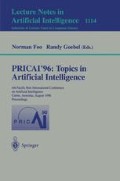Abstract
In this paper, we present a computational model for transforming discourses into Quasi-Mental Clusters (QMCs) through a convergence process. The process is interpreted as a particular transformation of a given set of discourse segments and concepts by examining the textual continuity. Examinations include testing the local cohesion in a cohesion parsing as well as the global coherence in semantic decomposition. In the convergence process, sentences in a discourse are represented as nodes in a spreading activation network. Competing coalitions of the nodes drive the network into a stable equilibrium. We argue the resulting QMCs are useful data structures in remembrance, summarization and knowledge discovery in discourses.
Preview
Unable to display preview. Download preview PDF.
References
Anderson, J.A., & Murphy, G.L. (1986). Psychological concepts in a parallel system. Physica D, 22, 318–336.
Brainerd, C.J., & Reyna, V.F. (1990). Gist is the grist: Fuzzy-trace theory and the new intuitionism. Development Review, 10, 1, 3–47.
Chan, S.W.K. (1995). Inferences in natural language understanding. Proceedings of the Fourth IEEE International Conference on Fuzzy Systems, Yokohama, Japan, 935–940.
Chan, S.W.K., & Franklin, J. (1994). Symbolic connectionism in tiers: A strategy of discourse comprehension. In C. Zhang, J. Debenham, & D. Lukose (Eds.), Artificial Intelligence: Sowing the Seeds for the Future, World Scientific, 434–441.
Chan, S.W.K., & Franklin, J. (1995). A neurosymbolic integrated model for semantic ambiguation resolution. Proceedings of the IEEE International Conference on Neural Networks, Perth, Australia, 2965–2970.
Ehrlich, M.-F., & Charolles, M. (1991). Aspects of textual continuity: Psycholinguistic approaches. In G. Denhiere & J.-P. Rossi (Eds.), Text & Text Processing, North-Holland, 269–285.
Ellis, H.C., & Hunt, R.R. (1989). Fundamentals of Human Memory and Cognition. Dubuque: Brown.
Fletcher, C.R., Hummel, J.E., & Marsolek, C.J. (1990). Causality and the allocation of attention during comprehension. Journal of Experimental Psychology: Learning, Meaning, and Cognition, 16, 2, 233–240.
Grosz, B.J. (1974). The structure of task oriented dialogs. IEEE Symposium on Speech Recognition, Pittsburgh, 250–253.
Grosz, B.J., Joshi, A.K., & Weinstein, S. (1995). Centering: A framework for modeling the local coherence of discourse. Computational Linguistics, 21, 203–225.
Grosz, B.J., & Sidner, C.L. (1986). Attention, intention, and the structure of discourse. Computational Linguistics, 12, 175–204.
Halliday, M.A.K., & Hasan, R. (1976). Cohesion in English. London: Longman.
Johnson-Laird, P.N. (1983). Mental Models. Cambridge, MA: Harvard University Press.
Kintsch, W., & van Dijk, T.A. (1978). Toward a model of text comprehension and production. Psychological Review, 85, 5, 363–394.
Stein, N.L., & Glenn, C.G. (1979). An analysis of story comprehension in elementary school children. In R.O. Freedle (Ed.), New Directions in Discourse Processing. Hillsdale, NJ: Erlbaum, 53–120.
Trabasso, T., & Sperry, L.L. (1984). Causal cohesion and story coherence. In H. Mandl, N.L. Stein, & T. Trabasso (Eds.), Learning and Comprehension of Text, NJ: Erlbaum, 83–111.
van Dijk, T.A., & Kintsch, W. (1983). Strategies of Discourse Comprehension. NY: Academic.
Waltz, D.L., & Pollack, J.B. (1985). Massively parallel parsing: A strongly interactive model of natural language interpretation. Cognitive Science, 9, 51–74.
Zwaan, R.A., Magliano, J.P., & Graesser, A.C. (1995). Dimensions of situation model construction in narrative comprehension. Journal of Experimental Psychology: Learning, Memory, and Cognition, 21, 2, 386–397.
Author information
Authors and Affiliations
Editor information
Rights and permissions
Copyright information
© 1996 Springer-Verlag Berlin Heidelberg
About this paper
Cite this paper
Chan, S.W.K., Franklin, J. (1996). Remembrance of discourse based on textual continuity: A spreading activation network. In: Foo, N., Goebel, R. (eds) PRICAI'96: Topics in Artificial Intelligence. PRICAI 1996. Lecture Notes in Computer Science, vol 1114. Springer, Berlin, Heidelberg. https://doi.org/10.1007/3-540-61532-6_19
Download citation
DOI: https://doi.org/10.1007/3-540-61532-6_19
Published:
Publisher Name: Springer, Berlin, Heidelberg
Print ISBN: 978-3-540-61532-3
Online ISBN: 978-3-540-68729-0
eBook Packages: Springer Book Archive

